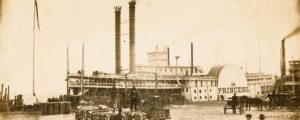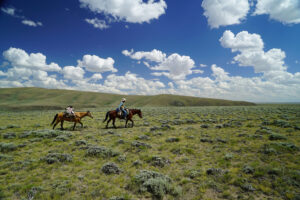Tinton is tucked in the rugged recesses of Spearfish Canyon, 13 miles due east of Deadwood. Its crumbling edifices belie a remarkably resilient mining town. Edgar St. John discovered ore there during the mid-1870s Black Hills Gold Rush. The vein was short-lived, but rich silver diggings became Tinton’s lifeblood for the next two decades. By the late 1890s the silver was running thin just as miners were unearthing plentiful tin, tantalite and feldspar deposits.
The Tinton Times, published downtown, served as a sounding board for both miners and mine owners. The following items appeared in the May 21, 1903, edition under “Tinton Topics”:
The Tinton Company is this week opening up the richest vein of tin ore yet encountered.
Mr. Charles Waite, general manager of the Tinton Company, arrived this week from Omaha and points east.
Scoville and Snyder have finished their drift and started a new tunnel that will show up a bonanza before the summer is over.
Advertisements touted such businesses as the Tinton Mercantile, the Negro Hill Tin Company in Bear Gulch and Mac the Saddler, a Deadwood-based saddle and harness maker.
Tinton boasted amenities found in most mining camps, including a post office, a company store, a two-room school and local sports teams, fraternities and ladies groups. But surprisingly, this camp full of miners claimed few bars or taverns. On May 12, 1903, the Miners’ Assembly Hall hosted the town’s first wedding. Mrs. Allington, proprietress of the local boarding house, organized a dance accompanied by the Tinton Orchestra.
About 1926, as mining again waned, John Bland formed the Black Hills Resort Company, intending to transform Tinton into a playground for the rich, complete with a clay tennis court and nine-hole golf course. Onetime miners’ homes were slated for use as guesthouses.
Citizens banded together in 1927 to build a community hall. Relatively large by contemporary standards, it boasted a basketball court and could hold as many as 200 spectators to watch live theater or “moving pictures” projected on a makeshift screen.
Before the resort plans could be finalized, a new method of extracting ore gave the mine the boost it needed. With a new business partner, it was up and running again by 1928.
In 1929 Tinton resident John Perrott, a 4-foot-3 Welshman nicknamed Potato Creek Johnny, panned what was likely the largest gold nugget ever found in the Black Hills. W.E. Adams paid $250 for the 7 ¾-ounce nugget and displayed it in his eponymous museum. (It now rests in a Deadwood bank vault.) Some newspapers accused Johnny of foul play, claiming his “nugget” was actually a mass of melted ore stolen from a fellow miner. Despite the controversy—or perhaps because of it—he became one of the Black Hill’s best-known residents. He is buried in Deadwood’s Mount Moriah Cemetery.
A spectacular fire in January 1943 effectively brought an end to Tinton, as the huge mill that supported the town burned to the ground. Since then various companies have bought the site and run the operations, only to sell out again. But most residents gradually drifted elsewhere, leaving the townsite to the crows and coyotes.
Today, Tinton boasts more standing buildings than any other South Dakota ghost town—though they speak to long winters and minimal state preservation efforts. None has a roof that isn’t in some state of collapse. Tinton Enterprises owns the land and bars trespassing to protect itself and the public. (This author had written permission to visit the site.)
Originally published in the August 2009 issue of Wild West. To subscribe, click here.




